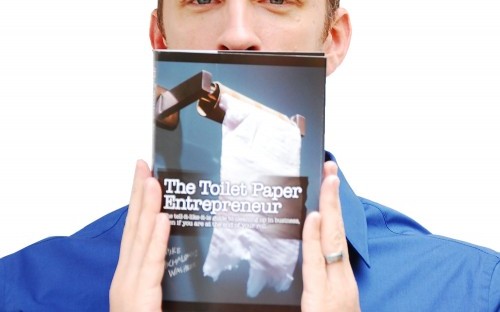Mike’s first book, ‘The Toilet Paper Entrepreneur’, argues that a lack of funding can actually drive your company to greater success, by forcing you to be more resourceful. It has been translated into several languages and gained a cult following for its straight-talking advice, idiosyncratic take on business strategy, and irreverent humour.
His newest book, ‘The Pumpkin Plan’, was released this year. Aimed at struggling businesses, Mike offers ‘A Simple Strategy to Grow a Remarkable Business in Any Field’, using pumpkin farmers as an unlikely source of inspiration.
We talk with Mike about accidentally stumbling upon entrepreneurship, why your business plan is probably a waste of your time, and the power of harnessing your fear.
Tell us about how you started up your first company.
When I graduated, I did the normal thing of applying for various different jobs in things like accounting, but I didn’t get any offers. In the end, I started work at a local computer company.
I use to moan with my friend about how much it sucked to be working so hard for our boss, who was earning all the money, but just seemed to be surfing the internet all day.
One night, when I was drunk, I rang up my boss to tell him that I wanted to quit, in not particularly polite terms! Of course, in the morning, I realised what I’d done and begged for my job back – not surprisingly, he said no.
I was 24 years old, married, with a son. The only way forward seemed to be to start a business, and the experience was horrible to begin with. However, the fear of failure kept me going, and before long it started to feel more like fun, and I was becoming more successful. I never planned to start my own business – I suppose I’m an accidental entrepreneur!
Could you sum up the concept of the 'Toilet Paper Entrepreneur'?
I built my first company without a single penny, and then managed to sell it for a lot of money. The fact that I didn’t have funds to begin with meant that I had to be more frugal, and decide what methods really did and didn’t work. Ironically, having no money makes you think better – which makes you more successful!
Because of my own success, I decided to write a book about it. I came up with the ‘toilet paper’ analogy for how to grow a business with severely limited resources. There are times when you go to the bathroom, and there are only three sheets of toilet paper left... but somehow, we make it work.
It’s a situation we all survive, even if we don’t really talk about it! Most people ensure that their struggles and challenges aren’t as visible as their successes. My book is about how you can run a successful business when you’re caught with the proverbial three sheets.
How is your new book, 'The Pumpkin Plan', different?
After ‘The Toilet Paper Entrepreneur’ had seemed to catch on, I realised that a lot of people had been inspired to start businesses, but that that their small businesses got quickly stuck in a trap. It seems that the only way to more make money is to keep working harder and harder, but the business stagnates and stops growing.
‘The Pumpkin Plan’ is about breaking out of that trap – making sure that the business serves you, not the other way round!
I came up with the analogy of the bizarre phenomenon where farmers strive to grow colossal vegetables. They all want to grow themselves a one ton pumpkin! What was so fascinating for me is that these farmers only change about 5% of things about the growing process, but the pumpkin responds with explosive growth.
The key is to identify these minor things to tweak, and apply it to business.
You suggest that a traditional business plan is a waste of time - why is this? Does this idea annoy some business people?
It definitely annoys business people – I get nasty emails about this all the time!
Traditional business plans try to define the target client, outline the ‘dream team’ of workers, and project financials. However, once you start the business, you realise a lot of things turn out differently to how you planned it.
The right client will reveal themselves over time, and will often be a surprise. If you rely on a ‘dream team’ of employees, you’re diverting attention away from the entrepreneurial core, which is what matters most. The most ridiculous part, however, is revenue predictions. If you could reliably predict revenue, even short term, you could make billions on the stock market overnight!
The business plan, in essence, is unrealistic hopefulness. A lot of people will write one, then never look at it again.
How should you plan a business instead?
I recommend what I call the ‘three sheet strategy’, going back to when you find yourself with limited toilet paper resources!
First, you need a vision of what you want to become. Then, you need to set a quarterly goal that directs the business towards where you want to be – you can just about have an idea of what might happen over the next quarter.
After three months, evaluate how successful you’ve been, and push forward again. Naturally, the direction will have adjusted slightly. Whilst most traditional business plans assumes progression along a straight line, my strategy allows a bit of zig-zagging.
Which high profile entrepreneur do you admire most?
I’m inspired by Dale Carnegie, who wrote the books ‘How to Win Friends and Influence People’ and ‘How to Stop Worrying and Start Living’ after setting up a training company.
He was really out to do good, and built a business on that principle. A lot of people do good things simply because they know they can make money out of it, but money didn’t come first for him. In my opinion, he did it the right way.
Do you think that anyone can develop entrepreneurial potential, or is it innate?
Whilst I think you have to be born with entrepreneurial potential, I also think it can be developed, and that a lot of people don’t know they have it. When I was 23, I had no interest in being an entrepreneur – it was only being drunk that allowed my entrepreneurial tendency to be exposed for a minute!
Entrepreneurs have to have a risk-taking mentality, a natural business talent, and be confident enough to put themselves out there. You also have to be unafraid of offending some people – usually your competition.
In the States, the five-finger shoes has become really popular, but to start with the product put off a lot of people. Wearers were attacked for having these ‘clown shoes’ on their feet! But a small faction became addicted, and love the invention. This is a great example of how a new idea can really polarise people.
Which of your achievements are you most proud of?
At the moment, it’s my second book, ‘The Pumpkin Plan’. I’m really lucky, because writing and talking about entrepreneurship is my passion. When my businesses have sold for millions of dollars, it might have felt good at the time, but the happiness soon subsided. My book, on the other hand, will outlive me, and continue to serve its purpose forever.
I self-published my first book, but ‘The Pumpkin Plan’ has been taken on by a major publisher, and everything seems to have come together. It’s pretty cool to have the physical presence of my own book on the shelf!
Could you tell us a bit about your current company, 'Obsidian Launch'?
Obsidian Launch is a fascinating company. The service monitors how people use websites, and evolves the website depending on the results. For example, you might have a tendency to click on red buttons more than blue ones – so a red necklace would probably appeal to you more than a blue one, too.
It’s about playing into website users' natural interests. The technology has been there for a long time, but Obsidian Launch is the first way for smaller companies to access it.
What advice would you give to an entrepreneur struggling to grow their business?
It’s really important to make a change. Change can be scary, but fear is a great tool that people tend to try and avoid. If it’s used properly, fear can motivate and keep the energy flowing.
For struggling businesses, it helps to think about how scary it is if you don’t make a change – normally, that fear’s worse! Sustained fear turns into stress, which can hurt you. The burst of fear you get from changing something can be the inspiration to make the difficult transition which will transform your business’ fortunes.
Find more entrepreneurial success stories by looking at what's Making the Headlines
RECAPTHA :
d1
c0
84
9f







